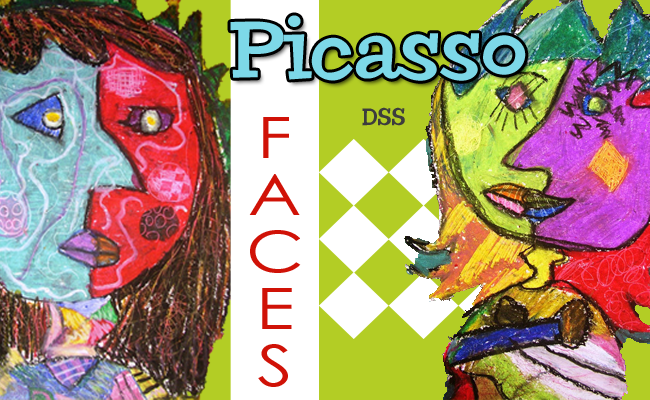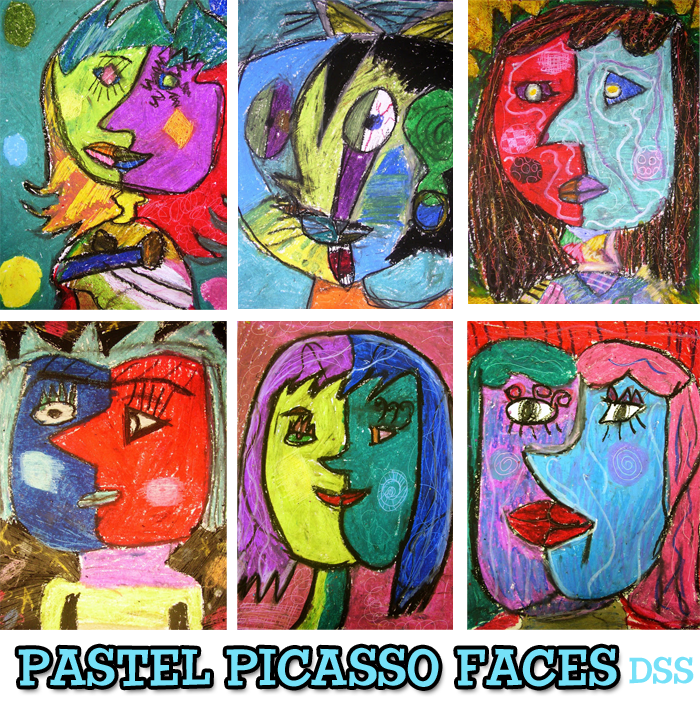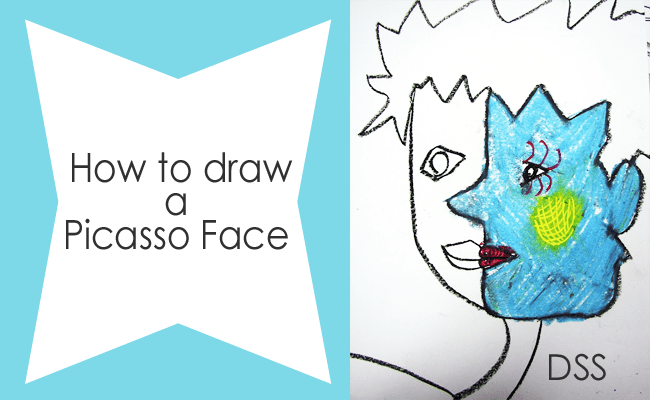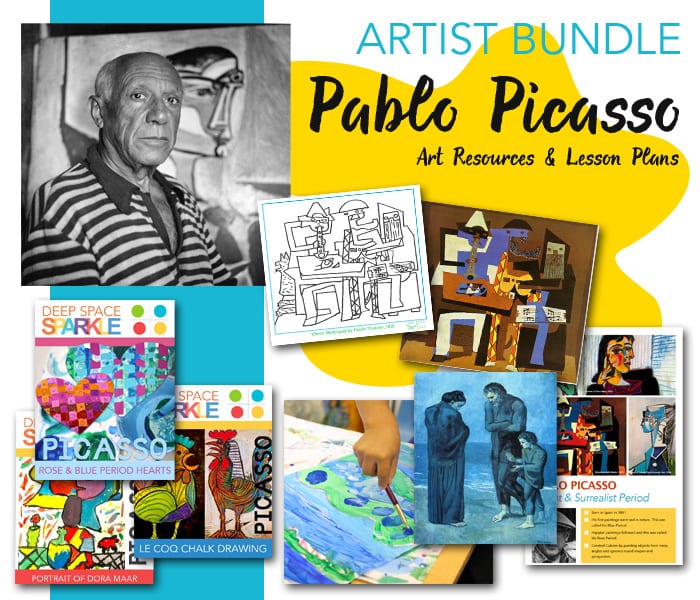If you don’t subscribe to Arts and Activities magazine, you should. It’s full of great lesson plans complete with great photos. I found this lesson in the March ’07 issue. Art teacher Jennifer Bowden submitted this lesson which I found extremely accessible to my fifth graders. I had done a Picasso Faces art lesson before with my first graders (see the lesson here) but this one is better suited for the older crowd.

HOW TO DRAW A PICASSO FACE
With a black oil pastel, draw a profile of a face down the middle of the paper (forehead, nose, mouth, chin). Start just below the top so you can leave room for hair. Instruct the children to think about the placement of the first line (middle of paper). Since this is a lesson in cubism, it’s best not to be perfect. Leave the neck for now then draw an eye looking to the side. To the left of the profile, draw a curved line from the top side of the head to the chin of the other face. On this face the kids draw an eye facing towards them. The mouth is where the kids join the two faces. This is also where they see how the two faces fit together. Draw hair, neck and shoulders on the other side.
COLORING A PICASSO FACE
Now the fun part. Color one side of the face one color and then chose a different color for the other side. Show the children how to layer oil pastel; color with a light colored pastel first then cover with a dark pastel. Using the wooden end of a paint brush or wooden dowel, children can scratch off the top layer of oil pastel to reveal the under layer. Some children will create some very intricate patterns.
The oil pastel should be applied heavily. This is where you need to encourage kids to put in their best effort. A lightly colored rendering is not what we’re after here. This works in their favor so if they want to scratch off the top layer later on, they can. For the final step, I ask the kids to trace over all the black oil pastel lines with a black oil pastel. This is a good time to add small details like eyelashes.















I’ve done this before with smaller children. We started with black construction paper (and used chalk for our original face sketches). That way if you have an unenthusiastic colorer, it still looks good because the viewer’s eye doesn’t see any white!
It is a great project: the kids have fun and like the results, and the parents are fascinated.
is the chalk too messy for 3rd graders what i mean are they at risk for getting upset with smears if so what would you recommend?
In this lesson, we used oil pastels not chalk pastels. Still, I don’t find that chalk smears have ever been a problem before in the sense that it upsets children. Some children don’t like the feeling of dry chalk but in my ten years teaching, there has only been a handful.
What kind of concerns do you have for chalk?
Very Colorful. Always the African Art remains attractive and very perfect in the color.
Here's a web feature that shows a wide range of Picasso's styles when painting faces: http://www.artsology.com/picassofaces.php
This is a great tool! Thanks for sharing 😀
planning a Spanish day at canterbury cross primary school, west midlands, UK.
was looking for help for picasso style painting for portrait… this is so perfect….
will feed back on outcomes
big thanks
Here’s a game where there are 200 paintings on a page, 199 of them are by Picasso, one is not … part of the idea is to show the wide range of painting styles that Picasso used, but then it’s also a game to try to pick the one that’s not.
http://www.artsology.com/pablo_picasso_gallery.php
Cool!
Hello
I am a Literacy Resource Teacher in Toronto.
We are working on a summer website to provide teachers and students ideas for the summer to engage them in literacy, math, and the arts.
I wondered if we could take from the above activity on Picasso a sample of student art to demonstarte an example tor the activities we have outlined for our students. We would source your website and the school where the student artists are from,
Please advise.
Thank you
Hi Emily,
I prefer that you don’t cut and paste the lesson, but if you would like, you can use one of the pictures and then refer your readers back to my site for the full lesson. It might be helpful to your readers to give the post URL and not the site URL.
I don’t give out students name or the school, so it is unnecessary to give school attribution.
Thank you.
And your website is beautiful and inspiring.
I love to do Picasso portraits. My favorite lesson is with markers. The students use two white 8×11 pieces of paper and on one draw a profile and the other frontal view just shoulders up. They can also be happy vs. sad, different emotions. Then, I have to cut them up in large puzzle like pieces and put them together in once face on a new piece of paper. Usually suggest a striped background. They are really cute!!
Thank you, Patty! I did this with my kindergartners this week. They came out so cool and we all had fun! It’s a keeper.
Hello Patty
Which lesson have u found takes less time, Picasso faces with oil pastels or the Picasso faces with watercolors?
Also when using the liquid watercolors how do the students not contaminate the colors ? I’ve noticed today that my yellow turned green after a student forgot to wash brush. But even when the brush is rinsed after a color, traces of the previous color gets into the next liquid water color. :(. How do you keep colors pure?
Carmela
Using watercolors takes less time. Whenever you are in doubt, try the lesson yourself. This will give you first-hand experience at how long it takes you. Then, double the time and you should be able to gauge roughly how long a child takes.
Please send me the Picasso resources and lessons plan bundle.
If you are having trouble downloading your purchase, please contact suppport@deepspacesparkle.com They’ll help you out 🙂
I did this with my third graders and they turned out great. We all had fun doing this project and the teacher directions were so clear! Thank you!!!
I’m looking forward to trying this lesson with my grade threes next week! I think I’ll have to practise at home a few times first 😉
i Love this reosurce
Love this lesson!
easy for students to follow. love it!
Looks great!